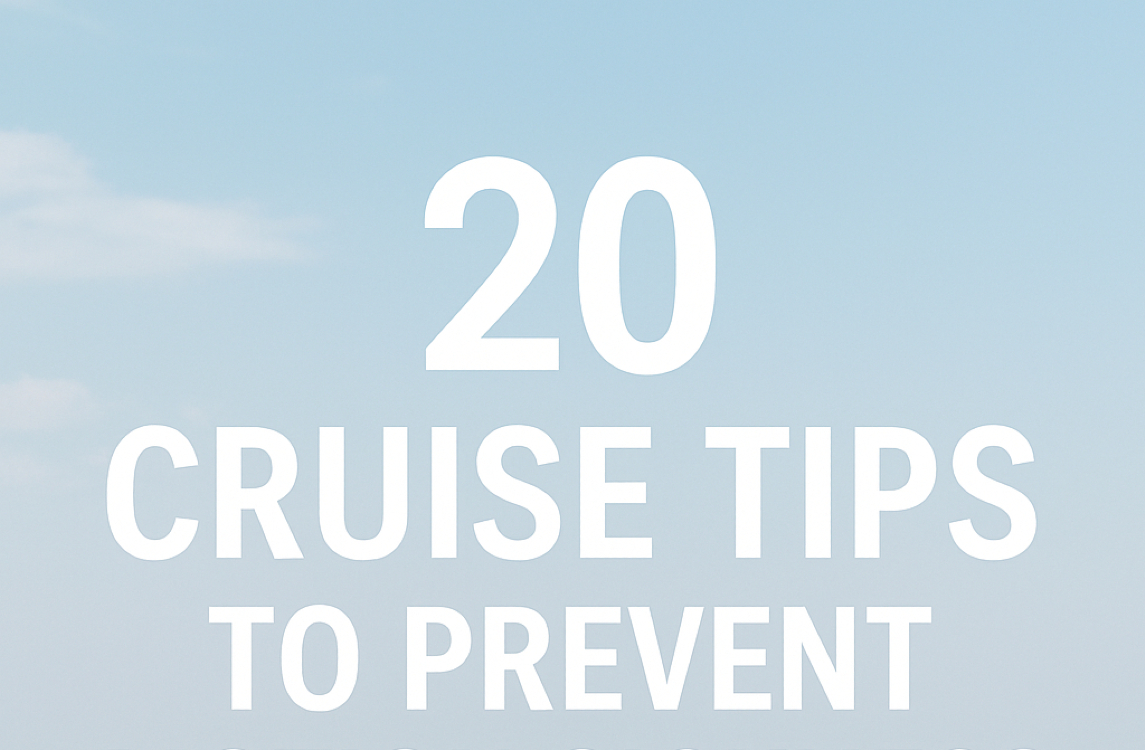20 Cruise Tips to Prevent Motion Sickness

Smooth Sailing: 20 Tips to Prevent or Manage Motion Sickness on a Cruise
There’s nothing like the thrill of setting sail—ocean breezes, endless horizons, and the excitement of new destinations. But for some travelers, there’s one nagging worry that can overshadow the adventure: motion sickness.
The good news? With the right strategies, you can enjoy your cruise without feeling queasy. Whether you’re a first-time cruiser or someone who’s felt wobbly at sea before, here’s everything you need to know to keep motion sickness at bay and make the most of your time onboard.
What Causes Motion Sickness on a Cruise?
Motion sickness happens when your brain gets mixed signals from your inner ear, eyes, and body. You might feel rocking under your feet, while your eyes see a steady cabin—or vice versa. This sensory mismatch confuses your brain and triggers symptoms like nausea, dizziness, headaches, and sweating.
Fortunately, plenty of practical tips and tools can help you stay comfortable. Let’s dive in!
20 Tips to Help Prevent or Manage Motion Sickness at Sea
✅ 1. Choose a Midship, Lower-Deck Cabin
Your cabin’s location matters—a lot. The lower and closer to the middle of the ship you are, the less movement you’ll feel. Avoid cabins near the front (bow) or rear (stern) where the rocking and swaying can be more pronounced.
✅ 2. Sail on Larger, Modern Ships
Modern cruise ships often have sophisticated stabilizers that reduce side-to-side movement. If motion sickness is a concern, choosing a newer or larger vessel can make a big difference in your comfort level.
✅ 3. Cruise During Calmer Seasons
Timing your cruise around smoother weather is a smart strategy. For instance, avoid hurricane season in the Caribbean or rough winter seas in the North Atlantic. Calmer seas mean less motion—and a more relaxing trip.
✅ 4. Keep Your Eyes on the Horizon
Looking at a stable, distant point like the horizon helps your brain reconcile the movement your body feels. It’s a simple but highly effective trick for reducing symptoms.
✅ 5. Get Fresh Air Whenever You Can
Feeling queasy? Step outside. Fresh air can help reduce nausea, and gentle breezes can soothe your senses. Booking a balcony cabin is a great option for quick access to open air.
✅ 6. Stay Hydrated
Dehydration can make motion sickness worse. Sip water throughout the day, but avoid chugging large amounts quickly. Go easy on sugary drinks or sodas, which may upset your stomach further.
✅ 7. Eat Light, Bland Meals
Heavy, greasy, or spicy meals can worsen nausea. Instead, opt for light, bland options like toast, crackers, or plain rice, especially on days when the sea is rough.
✅ 8. Avoid Excessive Alcohol
While a cocktail or two is part of the cruise experience, alcohol can dehydrate you and worsen dizziness or nausea. Drink in moderation if you’re prone to motion sickness.
✅ 9. Try Ginger
Ginger has natural anti-nausea properties. Bring along ginger candies, ginger tea, or even ginger capsules to help settle your stomach naturally.
✅ 10. Wear Acupressure Bands
Wristbands like Sea-Bands press on specific pressure points thought to reduce nausea. Many cruisers swear by them, and they’re a drug-free option worth trying.
✅ 11. Use Over-the-Counter Medications
Products like Dramamine or Bonine (meclizine) can be helpful for preventing or reducing symptoms. Take these before you feel sick for the best results. Always check with your doctor first.
✅ 12. Talk to Your Doctor About Prescription Options
If you’re highly susceptible to motion sickness, ask your doctor about prescription treatments like scopolamine patches, which are worn behind the ear and release medication slowly over several days.
✅ 13. Rest and Get Plenty of Sleep
Fatigue can make motion sickness worse. Aim for a good night’s sleep before embarkation and pace yourself during your cruise to stay well-rested.
✅ 14. Avoid Reading or Excessive Screen Time
Staring at small print, books, or your phone screen while the ship is moving can confuse your brain further and worsen symptoms. Try looking outside instead, or close your eyes and relax.
✅ 15. Practice Deep Breathing
Slow, deep breaths can help calm your body and mind when you feel symptoms starting. Focus on exhaling longer than you inhale to ease anxiety and nausea.
✅ 16. Keep Cool
Overheating can aggravate motion sickness. Dress in light layers, seek out air-conditioned spaces, and avoid sitting directly in the sun if you’re feeling unwell.
✅ 17. Stay in Well-Lit Areas
Dim lighting can worsen dizziness and disorientation. If you’re prone to motion sickness, stick to brighter areas of the ship, especially when moving around.
✅ 18. Avoid Strong Odors
Heavy food smells, perfumes, or even engine fumes can trigger nausea. Move away from strong odors as soon as you notice them.
✅ 19. Don’t Wait Until You Feel Sick
Prevention is key. If you’re prone to motion sickness, start taking medication or using your preferred remedy before you step onboard or as soon as the ship sails.
✅ 20. Try a Shorter Cruise First
If you’ve never cruised before, consider booking a shorter itinerary to test the waters—literally. You’ll get a feel for how your body handles ship movement without committing to a longer voyage.
Final Thoughts
Motion sickness doesn’t have to ruin your cruise dreams. With a bit of planning and the right strategies, you can enjoy everything cruising has to offer—from gourmet dinners to breathtaking sea views—without feeling queasy.
Still worried about seasickness? Let’s chat! I’m here to help you choose the right ship, itinerary, and stateroom so you can cruise with confidence and make the most of your time at sea.
Ready to plan your perfect cruise adventure? Visit orthtravelcollective.com for more inspiration!


